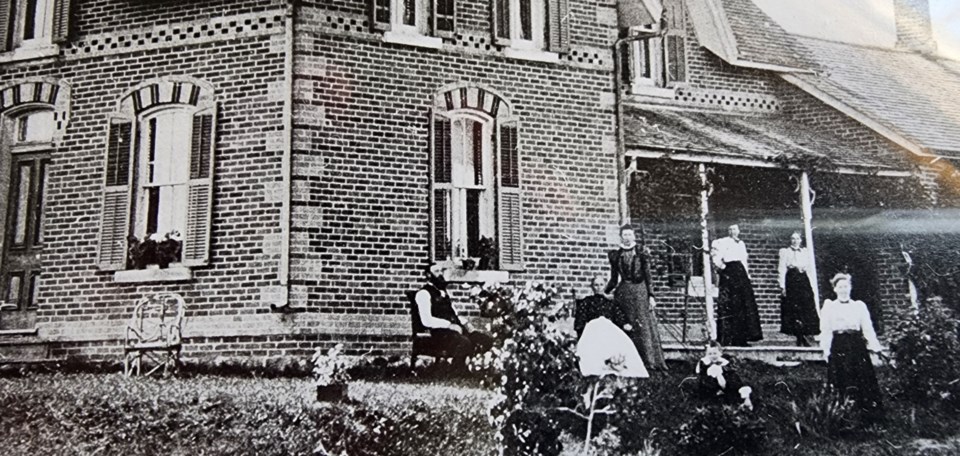Quite by happenstance, last week I met a man whose family owns Dunbrody Farm on the 1st Line of Innisfil.
Bill Masters, now a member of Innisfil Historical Society, shared this story:
“My dad had a business on Church Street in Toronto. One of the people who ‘hung out’ at his store was a guy named Al James. This same person told my dad that his wife, Mrs. James, was a housekeeper for Elmer Rothwell, on a farm in Innisfil. My dad learned that the farm was being sold and eventually bought the farm. This would have been some time in the mid-’60s," he said.
"I am the eldest of four sons and was 21 when my dad bought the farm in 1968, so I never lived there. Tim, second son, sold real estate from the farm for a couple of years, followed by Gary, who, being a firefighter, was able to do some farming on a small scale (a few cows, chickens and horses). Andy, the youngest, lives there now," Masters added.
Their parents, Russell William Masters (1919-2009) and Dora McKenzie Moir Masters (1922-2022), retired to the granny flat that sits near the main farmhouse.
Ah, but who lived there first?
A noteworthy listing appears in the 1872-73 Gazetteer for Simcoe County, stating William Rothwell, a farmer, resided in the area of Gilford, a village and station of the Northern Railway that boasted a population of 250 at that time.
William and his wife, Suzannah Todd, settled on Part Lot 20, Concession 1, later adding the southeast quarter of Lot 19. Their family consisted of seven sons, Elmer being the youngest, and four daughters.
Over time, the log house and barn were replaced by modern buildings and named Dunbrody Farm.
The original sailing ship, Dunbrody, was built in 1845 in Quebec. She was commissioned, along with seven sister ships, and built by expert shipwright Thomas Hamilton Oliver, an Irish emigrant from County Derry.
In 1845, the year of her launch, the Irish potato crop failed and food prices soared, igniting what would become the Great Famine. Widespread starvation would soon force more than a million people to flee the country. So many people left at the same time, there were not enough passenger ships to carry them all.
Enterprising merchants took the opportunity to fit out their cargo vessels with bunks to meet the extra demand. Between 1845 and 1851, the Dunbrody carried thousands of emigrants to North America.
A ship the size of the Dunbrody was allowed by law to carry anywhere from 160 to 300 passengers.
In 1847, she is recorded as carrying 313 passengers to Quebec. Only two classes of passengers were carried — cabin passengers, who paid between five and eight pounds, and steerage passengers, who paid between three and four pounds.
Cabin passengers had substantial food and services provided, while steerage passengers mostly had to fend for themselves.
Within the first months of spring 1847, 40 ships were waiting to disembark at the quarantine station at Grosse-Île, Que. With the station utterly overwhelmed by the numbers arriving, many people were forced to wait for weeks before they could even leave their ships.
Unlike other ships, the Dunbrody’s onboard mortality rate was low. This was, without doubt, due to her efficient and humane captains, Baldwin and his successor, John W. Williams.
On more than one occasion, emigrants writing back home praised their care and dedication to both crew and passengers. Now the Dunbrody Famine Ship is one of the premier tourist attractions in the South East of Ireland. Centred on an authentic reproduction of an 1840s emigrant vessel, it provides a world-class interpretation of the famine emigrant experience.
The Innisfil Historical Society has also announced that Nick Hurdman will speak this afternoon (March 16) at the Knock School Heritage Site at 2 p.m.
In Hurdman’s words: “Our project began as a typical family tree with names and key dates. Along the way we rediscovered old family albums and that put faces to names. Those faces would have had many stories and those stories were aching to be told.
What captured my attention most were stories of those who left their homes and travelled long distances to face an uncertain future in Canada. I became fascinated by the story of my wife’s second great-grandparents, Thomas Rathwell and Ann (Fennell) Rathwell, their six children, plus Thomas’s two brothers who emigrated from Ireland during the spring of 1847 on the sailing ship Dunbrody.
It's unclear exactly why the spelling of the Rathwell name changed over the years.
But Hurdman, who classifies himself as an amateur genealogist and a family history buff, creates a visual experience that brings the subject matter to life. \
Coincidentally, St. Patrick’s Day is near at hand. I wonder what refreshments will be featured.



